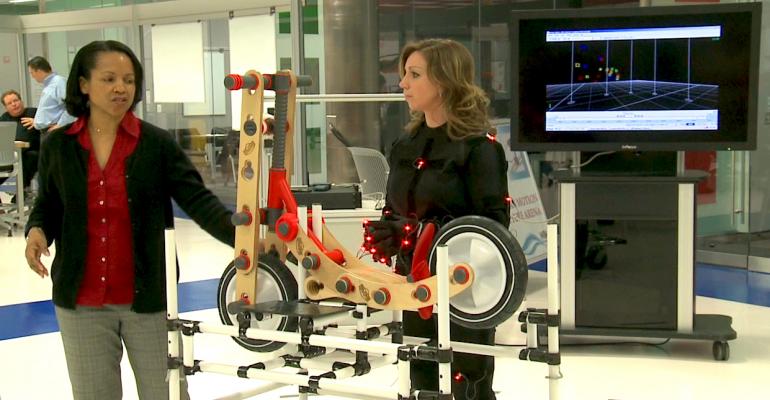WARREN, MI – Chrysler is enrolling in higher learning at the technology training center it operates here with the United Auto Workers union.
The auto maker and the UAW today are cutting the ribbon on its “WCM Academy,” where hourly and salaried employees will come to learn the finer points of Fiat’s World-Class Manufacturing system.
Inspired by procedures developed and refined by Japan’s auto industry, WCM is a culture-based protocol for identifying and resolving production problems at the shop-floor level.
It contributed to Fiat’s renaissance in 2004 and was launched at Chrysler in 2009 when the Italian auto maker took management control of the then-flagging pentastar company.
A one-of-a-kind oasis of advanced technology designed to promote the kind of thoughtful analysis that triggers innovation, the academy represents Chrysler’s graduation to a new level of integration with Fiat.
“Now we can have a better a way to teach, to create our Chrysler know-how,” says Massimo Risi, Chrysler’s head of World-Class Manufacturing. “What makes the difference between a competitive company and a slower company is the competence of its people.”
And there is a direct correlation between competence and the appropriate use of analytical tools provided by WCM training. “You cannot just ask them to do their best,” Risi adds.
WCM invites the practiced eye of an assembler to deconstruct, a new work station, for example. The goal: to improve ergonomics to such a degree that a worker is free to focus on the task at hand instead of how to safely accomplish that task.
To this end, WCM trainees at the academy can employ motion-capture technology. This enables mapping of a worker’s movements by attaching sensors to ankles, knees, elbows, wrists and fingers.
It is the same technology Hollywood has used in movies such as Avatar and Beowulf so the movements of animated characters appear more lifelike.
Initial investigations using the technology often reveal shocking results – wasted movement WCM Academy Lead Scott Tolmie likens to swatting flies. After the kind of analysis afforded by motion-capture, the same worker “looks like he’s a surgeon.”
Among the other teaching aids is 3-D immersion. When trainees wear earphones and military-style 3-D goggles to witness a scenario such as a workplace accident, the impact is indelible, Tolmie says.
WCM replaced Smart Manufacturing as Chrysler’s quality-enhancement system. But Tolmie insists Fiat’s system is not “the flavor of the month.”
A UAW insider who requests anonymity notes WCM’s organizational structure resembles an inverted triangle and workers represent the point on which the system is supported. Smart Manufacturing resembled a pyramid, with management at the top. Solutions trickled down from there, the insider says.
“WCM has engaged and empowered our UAW-represented workforce by challenging them to become more involved in driving change within our plants,” UAW Vice President General Holiefield tells WardsAutoin an email.
“Our employees understand that WCM is the foundation of Chrysler Group’s continued success and the WCM Academy provides the opportunity for continued growth and development,” he writes. “By embracing WCM, we can secure manufacturing jobs and additional investment in our plants.”
Engagement is a reassuring concept for manufacturing guru Bob Miller, executive director of the Shingo Prize for Operational Excellence. A company improves its chances of success if it leverages the expertise of its workers.
“Responsibility needs to be pushed down to the people at the lowest level who are closest to the problem,” Miller tells WardsAutofrom Shingo’s headquarters in Utah.
Having “a group of experts flying in and fixing things and then flying out” does nothing to improve a company’s competence, he says, adding he is encouraged by Chrysler’s resolve to conduct such in-depth training off-site.
Even to impart the most vital information, it is impossible to “stop all of the busy work” associated with daily production, Miller says.
Plans are to accommodate more than 1,200 employees – hourly and salary – at the 25,000-sq.-ft. (2,323-sq.-m) academy every year. To date, 14 courses have been designed, but that number will increase to 24 by first quarter’s end.
Chrysler says WCM already has helped lower its warranty cost. The auto maker is mum on dollar amounts, but cites improvements at three plants.
Last year, workers at Chrysler’s Toledo assembly complex launched 270 WCM projects that generated $1.3 million in savings.
At the Jefferson North Assembly Plant, home to Jeep Grand Cherokee production, 128 “focused problem-solving” projects were initiated. As a result, it reduced by more than one-third the number of problems requiring correction before a vehicle moved to the next assembly station.
And at Chrysler’s minivan plant in Windsor, ON, Canada, human error was reduced by 0.5 percentage points in a trim zone, which translated to a decline from seven to two problems per 1,000 vehicles last year – a key metric for third-party quality evaluations.
Windsor workers are represented by the Canadian Auto Workers union. Though the CAW is not a stakeholder in the academy, its members can receive training there.





